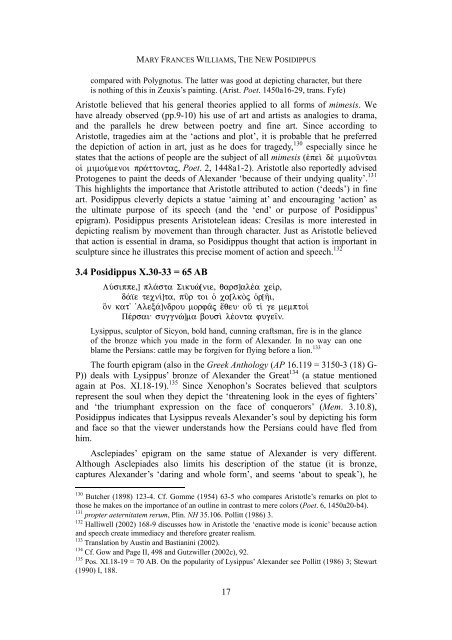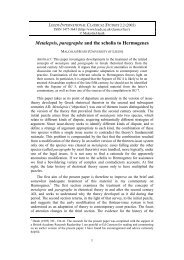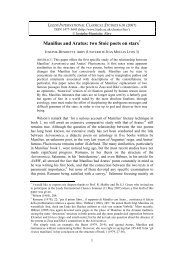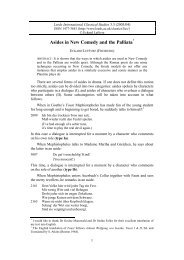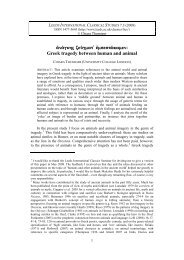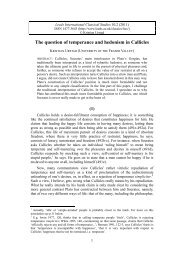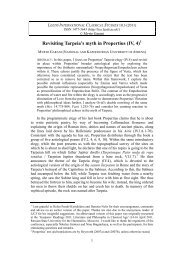The New Posidippus - Leeds International Classical Studies
The New Posidippus - Leeds International Classical Studies
The New Posidippus - Leeds International Classical Studies
You also want an ePaper? Increase the reach of your titles
YUMPU automatically turns print PDFs into web optimized ePapers that Google loves.
MARY FRANCES WILLIAMS, THE NEW POSIDIPPUS<br />
compared with Polygnotus. <strong>The</strong> latter was good at depicting character, but there<br />
is nothing of this in Zeuxis’s painting. (Arist. Poet. 1450a16-29, trans. Fyfe)<br />
Aristotle believed that his general theories applied to all forms of mimesis. We<br />
have already observed (pp.9-10) his use of art and artists as analogies to drama,<br />
and the parallels he drew between poetry and fine art. Since according to<br />
Aristotle, tragedies aim at the ‘actions and plot’, it is probable that he preferred<br />
the depiction of action in art, just as he does for tragedy, 130 especially since he<br />
states that the actions of people are the subject of all mimesis (peˆ d mimoàntai<br />
oƒ mimoÚmenoi pr£ttontaj, Poet. 2, 1448a1-2). Aristotle also reportedly advised<br />
Protogenes to paint the deeds of Alexander ‘because of their undying quality’. 131<br />
This highlights the importance that Aristotle attributed to action (‘deeds’) in fine<br />
art. <strong>Posidippus</strong> cleverly depicts a statue ‘aiming at’ and encouraging ‘action’ as<br />
the ultimate purpose of its speech (and the ‘end’ or purpose of <strong>Posidippus</strong>’<br />
epigram). <strong>Posidippus</strong> presents Aristotelean ideas: Cresilas is more interested in<br />
depicting realism by movement than through character. Just as Aristotle believed<br />
that action is essential in drama, so <strong>Posidippus</strong> thought that action is important in<br />
sculpture since he illustrates this precise moment of action and speech. 132<br />
3.4 <strong>Posidippus</strong> X.30-33 = 65 AB<br />
LÚsippe,] pl£sta Sikuè[nie, qars]alša ce…r,<br />
d£Že tecn…]ta, pàr toi Ð ca[lkÕj Ðr[Ái,<br />
Ön kat' 'Alex£]ndrou morf©j œqeu: oÜ t… ge mempto…<br />
Pšrsai: suggnè]ma bousˆ lšonta fuge‹n.<br />
Lysippus, sculptor of Sicyon, bold hand, cunning craftsman, fire is in the glance<br />
of the bronze which you made in the form of Alexander. In no way can one<br />
blame the Persians: cattle may be forgiven for flying before a lion. 133<br />
<strong>The</strong> fourth epigram (also in the Greek Anthology (AP 16.119 = 3150-3 (18) G-<br />
P)) deals with Lysippus’ bronze of Alexander the Great 134 (a statue mentioned<br />
again at Pos. XI.18-19). 135 Since Xenophon’s Socrates believed that sculptors<br />
represent the soul when they depict the ‘threatening look in the eyes of fighters’<br />
and ‘the triumphant expression on the face of conquerors’ (Mem. 3.10.8),<br />
<strong>Posidippus</strong> indicates that Lysippus reveals Alexander’s soul by depicting his form<br />
and face so that the viewer understands how the Persians could have fled from<br />
him.<br />
Asclepiades’ epigram on the same statue of Alexander is very different.<br />
Although Asclepiades also limits his description of the statue (it is bronze,<br />
captures Alexander’s ‘daring and whole form’, and seems ‘about to speak’), he<br />
130<br />
Butcher (1898) 123-4. Cf. Gomme (1954) 63-5 who compares Aristotle’s remarks on plot to<br />
those he makes on the importance of an outline in contrast to mere colors (Poet. 6, 1450a20-b4).<br />
131<br />
propter aeternitatem rerum, Plin. NH 35.106. Pollitt (1986) 3.<br />
132<br />
Halliwell (2002) 168-9 discusses how in Aristotle the ‘enactive mode is iconic’ because action<br />
and speech create immediacy and therefore greater realism.<br />
133<br />
Translation by Austin and Bastianini (2002).<br />
134<br />
Cf. Gow and Page II, 498 and Gutzwiller (2002c), 92.<br />
135<br />
Pos. XI.18-19 = 70 AB. On the popularity of Lysippus’ Alexander see Pollitt (1986) 3; Stewart<br />
(1990) I, 188.<br />
17


